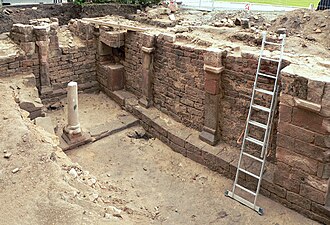Petersstift Nörten
The Petersstift Nörten was a collegiate monastery in Nörten that existed from 1055 to 1803. After the patronage of Peter and Mary it was called Petersstift. The associated collegiate church in Nörten was destroyed in the Thirty Years War .
prehistory
Around 1000 the exact extent of the diocese of Mainz to the north was still unclear. The Christianization mission in Fulda to the north had come to a standstill, as the Brunshausen monastery had remained isolated, so that Mainz was responsible for missionary work. Nevertheless, the secular allocation of places to districts from Franconian times did not coincide with the clerical one, especially since the district division was dissolved in favor of various secular territorial rulers. Natural spatial and traffic conditions therefore played a greater role. Border locations of the original parishes of Mainz were about Dassel in the northwest (across from Corvey , Paderborn and Hildesheim ), Greene in the north (across from the Reichsstift Gandersheim ) and Gittelde in the northeast (across from Hildesheim and Halberstadt ). The foundation of the planned for the expansion of the monastery was therefore in its central position and was therefore even cheaper than the Pöhlde monastery .
Archdeaconate
Archbishop Luitpold I ( Archbishop of Mainz from 1051 to 1059 ) founded the monastery in 1055 . The churches in Nörten ( St. Martin ) and Geismar were the first monastery equipment . The monastery also took over the archpriesthood of Nörten , from which the archdeaconate seat developed. In the centuries that followed, further churches were founded in the vicinity of the original parishes and the parish organization was improved. From around the time of Adalbert , the secular administration was shifted to Rusteberg Castle (for limited tasks also to the Hardenberg and Gieselwerder castles ). The centralization of spiritual jurisdiction in the office of archdeacon, i.e. in the hands of the provost, provoked a small counter-movement in which some pastors in this district joined together to form calandas , including the St. Georgs Kaland Göttingen. The development of the monastery reached its peak around 1500, as the Reformation was introduced in 1542 in the Principality of Calenberg , to which Nörten already belonged . With that the archdeaconal office expired. The men's convention did not join the Reformation. In 1626 Duke Christian von Braunschweig had the monastery burned down. A few years later, the canons resumed their work. Belonging to Mainz formally ended in 1815 when the monastery fell to the Kingdom of Hanover .
Mainz archdeaconates to the south had their seat in Hofgeismar , Fritzlar , Heiligenstadt and Jechaburg . The clerical exclave was the archdeaconate Einbeck of the Alexandristift .
In 1500, the Archdeacon was Norten next to the Chapter of Canons themselves from the conventions of the monasteries Bursfelde , Katlenburg , Northeim , Pöhlde, Reinhausen , Steina and Zellerfeld , the convents of nuns monasteries Fredelsloh , Höckelheim , Lippoldsberg , Mariengarten , Osterode , Weende and Wiebrechtshausen and the Sedes (i.e. archpriest churches with assigned parish churches) Berka (55 churches), Dransfeld (22 churches), Geismar (40 churches), Greene (9 churches), Hohnstedt (20 churches), Moringen (16 churches), Nörten (34 churches), Oedelsheim (20 churches), Oldendorf (24 churches), Seeburg (19 churches), Sieboldshausen (26 churches) and Stöckheim (14 churches).
Toast

- The first provost is not known.
- Aeppelin about 1082
- Adelger approx. 1095–1102
- Walther approx. 1123–1141
- Sigelo around 1144
- Gottschalk von Schwalenberg approx. 1162–1190
- Eppo ca.1208
- Friedrich I of Everstein around 1222
- Lupold von Hanstein approx. 1265-1315
- Heinrich von Rodenstein approx. 1317-1328
- Johann Unterschopf approx. 1328–1335
- Kuno II. Von Falkenstein approx. 1335–1346
- Johann von Plesse approx. 1346–1363
- Hermann II of Hesse around 1363
- Dietrich von Hardenberg
- Heinrich von der Linden
- Johann von Driven
- Wilhelm, called Cardinael
- Arnold, called Cardinael
- Heinrich Ernesti ca.1394
- Detmar von Hardenberg ca.1403
- Johann Stalberch ca.1403
- Baroncus Philippi de Pistorio ca.1404
- Heinrich Sydenhemede ca.1404
- Hildebrand von Uslar approx. 1404–1422
- Johann von Rengelrode approx. 1424–1441
- Johann Swan Wing approx. 1441–1466
- Gebhard von Hardenberg approx. 1468
- Jakob Rauw approx. 1470–1480
- Tilemann Brandis around 1482
- Johann Pleker approx. 1519–1537
- Johann Hornemann 1538–1547
- Andreas Angerstein 1547–1570
- Henrich Bunthe 1570–1594
literature
- Alfred Bruns: The Archdeaconate Nörten . 1967
- Rudolf Eckart : Documented history of the Petersstift zu Nörten with special consideration of the history of Nörten and the surrounding southern Hanoverian landscape . 1899
- Johann Wolf : Diplomatic history of the Peters-Stift zu Nörten . 1799
